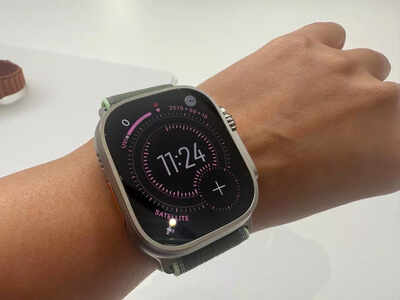ARTICLE AD BOX

Apple has finally launched the all-new Apple Watch Ultra 3, its most advanced and adventure-ready smartwatch, at its ‘Awe Dropping’ event on September 9. Released after a two-year gap, the Apple Watch Ultra 3 promises expanded health, fitness, safety, and connectivity features.
Priced at ₹89,900, the smartwatch brings meaningful upgrades in display, battery life, and health monitoring. We had the chance to spend some time with the Apple Watch Ultra 3, and here are our initial impressions of Apple’s latest rugged wearable.
Design
In terms of design, the Apple Watch Ultra 3 has maintained the bold and industrial design of the Watch Ultra 2. The smartwatch features the 49mm titanium case and a flat sapphire crystal display.
It has also retained the signature orange Action button placed on the left side. However, Apple has also made some refinements to the design of the Watch Ultra 3. Apple Watch Ultra 3 comes with a bigger and brighter display. The ultimate sports and adventure watch now features the largest screen of any Apple Watch, a display with a 1Hz always-on refresh rate.
The large display is surrounded by 24% thinner bezels which allows for a larger display area without increasing the case size.
The display brightness has also increased to 4000 nits which makes it the brightest display on an Apple Watch. Also, the wide-angle OLED display optimises each pixel to emit more light at wider angles, making it easier to read at a glance. Apple Watch Ultra 3 is available in natural or black titanium. A new collection of bands includes a Trail Loop design with reflective yarn along the edges, in addition to new colours for the Ocean Band and Alpine Loop.
The Hermès collection also gets two new colours for the En Mer band and a new Scub’H Diving band in rubber with a titanium buckle.
Features and performance
Apple Watch Ultra 3 is not just about looks. The adventure-ready smartwatch from Apple also offers new capabilities which will further enhance the user experience. Apple Watch Ultra 3 also comes with improved satellite connectivity. Apple Watch Ultra 3 allows users to text emergency services, message friends and family, and share their location, all while they’re off the grid.Apple also claims that the Watch Ultra 3 offers up to 42 hours of battery life — with up to 72 hours in Low Power Mode. We will talk about the detailed battery analysis in our complete review of the Watch Ultra 3.Apart from this, the Apple Watch Ultra 3 also delivers hypertension notifications. The notifications will alert users if signs of chronic high blood pressure — or hypertension — are detected. Hypertension notifications on Apple Watch use data from the optical heart sensor to analyse how a user’s blood vessels respond to the beats of the heart.
The algorithm works passively in the background reviewing data over 30-day periods, and will notify users if it detects consistent signs of hypertension.Another interesting feature is the sleep score. Apple Watch allows users to track sleep; measure important health metrics during sleep like heart rate, wrist temperature, blood oxygen, and respiratory rate; and even discover possible sleep apnea. Now, with watchOS 26, Apple Watch can help users understand the quality of their sleep and how to make it more restorative with a new sleep score feature.
Users can also choose to easily access their sleep score in a watch face complication or in the Smart Stack, and they can track their sleep scores over time in the Health app on iPhone.
What we think
Same as its predecessor, Apple Watch Ultra 3 has impressed us quite a bit in a short time. With the Watch Ultra 3, Apple has doubled down on matters most to its core audience: durability, visibility, and health intelligence. Priced at Rs 89,900, The Apple Watch Ultra 3 offers a bigger and brighter display, longer battery life and improved health and fitness features. For the complete analysis on the Watch Ultra 3 you will have to wait for our detailed review.



.png)
.png)
.png)
















 2 hours ago
4
2 hours ago
4







 English (US) ·
English (US) ·